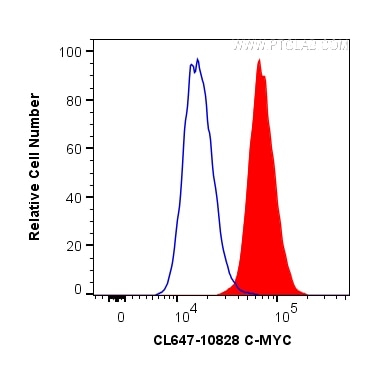- Phare
- Validé par KD/KO
Anticorps Polyclonal de lapin anti-c-MYC
c-MYC Polyclonal Antibody for FC (Intra)
Hôte / Isotype
Lapin / IgG
Réactivité testée
Humain
Applications
FC (Intra)
Conjugaison
CoraLite® Plus 647 Fluorescent Dye
N° de cat : CL647-10828
Synonymes
Galerie de données de validation
Applications testées
| Résultats positifs en FC (Intra) | cellules HeLa |
Dilution recommandée
| Application | Dilution |
|---|---|
| Flow Cytometry (FC) (INTRA) | FC (INTRA) : 0.20 ug per 10^6 cells in a 100 µl suspension |
| It is recommended that this reagent should be titrated in each testing system to obtain optimal results. | |
| Sample-dependent, check data in validation data gallery | |
Informations sur le produit
CL647-10828 cible c-MYC dans les applications de FC (Intra) et montre une réactivité avec des échantillons Humain
| Réactivité | Humain |
| Hôte / Isotype | Lapin / IgG |
| Clonalité | Polyclonal |
| Type | Anticorps |
| Immunogène | c-MYC Protéine recombinante Ag1263 |
| Nom complet | v-myc myelocytomatosis viral oncogene homolog (avian) |
| Masse moléculaire calculée | 49 kDa |
| Poids moléculaire observé | 62-65 kDa, 50 kDa |
| Numéro d’acquisition GenBank | BC000141 |
| Symbole du gène | MYC |
| Identification du gène (NCBI) | 4609 |
| Conjugaison | CoraLite® Plus 647 Fluorescent Dye |
| Excitation/Emission maxima wavelengths | 654 nm / 674 nm |
| Forme | Liquide |
| Méthode de purification | Purification par affinité contre l'antigène |
| Tampon de stockage | PBS with 50% glycerol, 0.05% Proclin300, 0.5% BSA |
| Conditions de stockage | Stocker à -20 °C. Éviter toute exposition à la lumière. Stable pendant un an après l'expédition. L'aliquotage n'est pas nécessaire pour le stockage à -20oC Les 20ul contiennent 0,1% de BSA. |
Informations générales
Function
c-Myc (also known as Myc), together with l-Myc and n-Myc, belongs to the Myc family of transcription factors. c-Myc has a basic helix-loop-helix leucine zipper domain and through heterodimerization can bind and regulate the transcriptional activity of genes, either by repression or activation. It is a key player in the regulation of cell growth and cell cycle progression and acts as a proto-oncogene.
Tissue specificity
c-Myc is ubiquitously expressed in almost all cell types and its expression positively correlates with tissue proliferative capacity. c-Myc is also expressed during embryogenesis and is upregulated in many cancer types.
Involvement in disease
· Upregulated in many cancer types, especially in aggressive, poorly differentiated tumors.
· Mutations in the MYC gene and breakpoint translocations within the MYC gene cause Burkitt lymphoma.
Isoforms
There are 3 different isoforms of c-Myc: c-Myc1, c-Myc2, and c-MycS (PMID: 16260605). They differ in molecular size, can be preferentially expressed during cell growth, and are reported to be functionally distinct.
Post-translational modifications
c-Myc is subject to various post-translational modifications, including phosphorylation, acetylation, and ubiquitinylation (PMID: 16987807), which regulate its activity.
Cellular localization
c-Myc localizes to the nucleus but can also be present in the cytoplasm of certain cancer types.
Protocole
| Product Specific Protocols | |
|---|---|
| FC protocol for CL Plus 647 c-MYC antibody CL647-10828 | Download protocol |
| Standard Protocols | |
|---|---|
| Click here to view our Standard Protocols |


